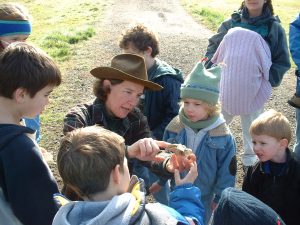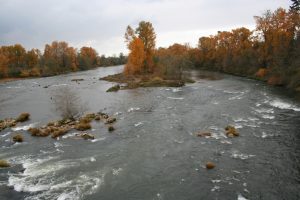October 11, 2016
Nearby Nature: Getting our youth outside.
Posted by smaguffin
As part of Earth Science Week, we’ll be highlighting different leaders in the geosciences – from research to education and community outreach. We are posting Q&A’s on The Bridge asking geoscientists about the work they do.
Today’s theme is No Child Left Inside Day and our feature is Nearby Nature, a non-profit organization based in Eugene, Oregon. We spoke with Holly Hartmann, a Nearby Nature Board Member and Events Volunteer. She is also the Principal at Holly C. Hartmann Consulting which helps decision makers apply climate science to community development and resource management.
Could you summarize the organization in a sentence or two?
Nearby Nature is a non-profit education group that seeks to foster appreciation of nature nearby and provide tools for ecological living. The group’s staff and volunteers lead nature walks, teach day-camps, work on restoration projects, host school programs, and teach classes at the Network Charter School in Eugene, Oregon. Most of the group’s work takes place in Alton Baker Park, a public green space located in the heart of the group’s urban community.
What are the biggest challenges in getting children involved in the outdoors?
Some of the biggest challenges in getting kids outside are: 1) funding — both for schools and families and 2) time — especially for teachers who have to spend too much time on testing and who have too many kids in their classrooms. Despite these challenges, thanks to Nearby Nature, our community’s kids spent more than 31,000 healthy hours outside in 2015!
How does Nearby Nature tie-in earth science education with your excursions?
We regularly talk about the geological history of the land in the park where we do our programs as well as geological processes in general. Oregon, with its wealth of volcanoes, rivers, and rocks is an excellent place to teach about earth science. We encourage kids to look for the “stories” that the land is telling — to check out everything from the shapes of the rocks underfoot to the lay of the land near our park’s river.
How do these activities supplement or contribute to traditional STEM education programs?
Our outdoor and indoor classroom programs complement science-oriented school activities that address everything from natural cycles, organisms, the history of planet earth, and the impact of humans on the environment.
How do you see the role of science and earth science in society?
It’s critical for everyone from tiny tots to wise elders to understand the way the earth’s natural cycles and processes work — and how our actions impact these cycles — without regard for the politics that sometimes cloud issues related to the environment. We try to teach kids about the science of the matter — and encourage them to ask questions, seek answers, and notice impacts.
How, if at all, is your working supported or affected by federal or state funding?
When schools suffer funding cutbacks, teachers have fewer resources for educational programs and field trips outside the classroom. The number of students we serve is directly impacted, especially by state schools funding. We do our best to secure scholarship support for kids in our community, but such funding cannot bridge the entire gap.
You can find out more about Nearby Nature on their website www.nearbynature.org and Facebook page at https://www.facebook.com/nearbynature.



